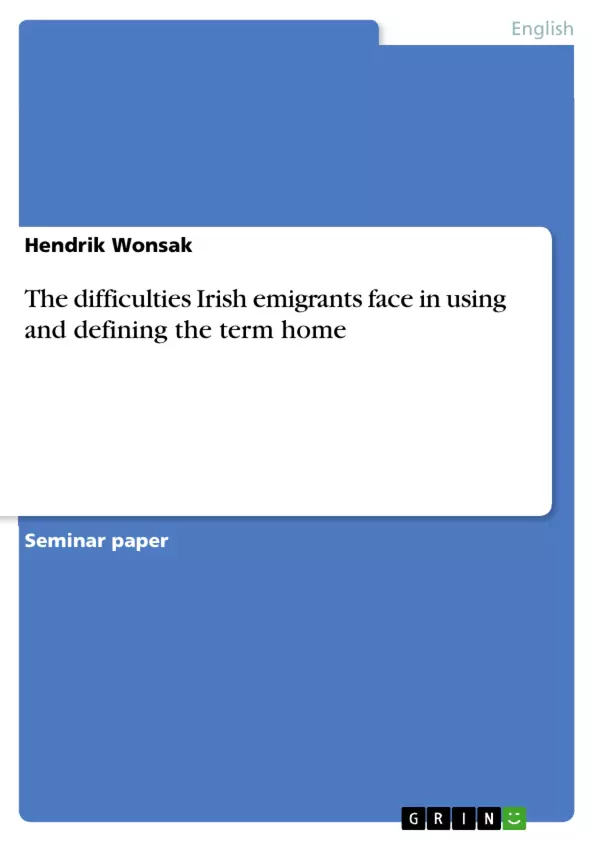In this term paper, I will try to work out the different meanings of the word “home” and observe, how the connotations of the noun changed for emigrants. Additionally, I will apply Martin Heidegger's theory of "Bauen, Wohnen, Denken" to the understanding of home in Colm Toibin's "Brooklyn" and Frank McCourt's "Tis".
The pictures of overcharged refugee ships on the frontpages of our daily newspapers, talk shows discussing possible bans of immigration on the radio and video clips of scared children hiding in shelters - the topic of emigration is omnipresent. Every year, there are millions of families leaving their old identities behind, seeking better lives in different countries.
Since 1800, roughly ten million Irish people have emigrated from the island. Events, such as the Great Irish Potato Famine, a period of starvation and illness from 1845 to 1851, or economical crises, caused mass emigration. During the depression of the 1950s, the act of emigration almost became a passage rite and three out of five Irish children emigrated. Since most people in Ireland were rather poor and the ship fares were costly, it was uncommon for complete families to emigrate. Mostly, parents sent their children to another country, in order for them to find a job, earn a living and send remittances back to Ireland. Most Irish emigrants settled down in England, Scotland, South Wales and especially in North America. Nowadays, there are 34.5 million people with Irish ancestry living in the United States of America. That is 11.1% of the total American population and more than six times the population of Ireland.
After their arrival in the United States of America, Irish emigrants were facing a variety of difficulties arising from religious and cultural differences between Ireland and the United States. A major difficulty for Irish emigrants was the meaning and the usage of the word home.
Inhaltsverzeichnis (Table of Contents)
- Introduction
- Home
- Just a word?
- Home in Colm Toibin's Brooklyn
- Home in Frank McCourt's Tis
- Comparison between Eilis Lacey and Frank McCourt
- ,,Building, Dwelling, Thinking"
- The concept
- Heidegger's theory applied to the act of emigration
- Conclusion
Zielsetzung und Themenschwerpunkte (Objectives and Key Themes)
The term paper aims to investigate the various interpretations of "home" for Irish emigrants, exploring how its connotations change through the experiences of leaving Ireland and establishing life in a new country. The paper focuses on applying Martin Heidegger's theory of "Bauen, Wohnen, Denken" to the understanding of "home" as portrayed in two prominent literary works: Colm Toibin's "Brooklyn" and Frank McCourt's "Tis."
- The multifaceted nature of the term "home" for Irish emigrants
- The impact of emigration on individual identity and sense of belonging
- The influence of cultural and societal differences on the perception of "home"
- The application of Heidegger's theory to the experience of emigration
- The emotional and psychological complexities of leaving one's homeland and establishing a new life elsewhere
Zusammenfassung der Kapitel (Chapter Summaries)
The introduction delves into the historical context of Irish emigration, highlighting the enduring significance of this phenomenon throughout history. It emphasizes the challenges faced by emigrants in navigating their identities and establishing a sense of belonging in new environments.
The chapter "Home - Just a Word?" examines the multifaceted nature of the word "home," exploring its linguistic and cultural connotations. The chapter explores the difficulty in defining "home" for emigrants, particularly those torn between their original home and their adopted one.
The chapter "Home in Colm Toibin's Brooklyn" analyzes the concept of "home" as it unfolds within the narrative of Colm Toibin's novel. The chapter explores the protagonist's evolving sense of belonging as she navigates her new life in New York City and grapples with the complexities of her Irish heritage.
The chapter "Home in Frank McCourt's Tis" investigates the notion of "home" through the lens of Frank McCourt's autobiographical work. The chapter examines the protagonist's childhood experiences and how they shape his understanding of "home," both in his native Ireland and his adopted America.
Schlüsselwörter (Keywords)
The paper focuses on key terms such as "home," "identity," "emigration," "belonging," "Irish diaspora," "cultural differences," "Heidegger's theory," "Bauen, Wohnen, Denken," "Colm Toibin," "Brooklyn," "Frank McCourt," and "Tis." These concepts are explored through a literary lens, examining how they intersect with the experiences of Irish emigrants.
- Quote paper
- Hendrik Wonsak (Author), 2015, The difficulties Irish emigrants face in using and defining the term home, Munich, GRIN Verlag, https://www.hausarbeiten.de/document/353950


